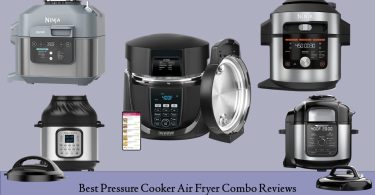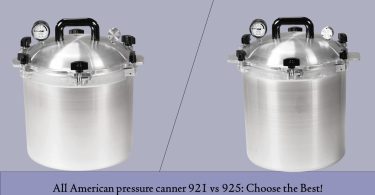Pressure canners and cookers are a great addition to any kitchen, allowing you to preserve food for long periods of time. The Presto 01781 Pressure Canner and Cooker and the Presto 01784 Induction Compatible Pressure Canner are two popular models. Each has its own advantages and disadvantages, so it can be difficult to decide which one to buy.
In this article, we will compare the two models, looking at their features, design, and price, to help you decide which one is right for you. We will also provide tips on how to use and care for your pressure canner to ensure it lasts for years to come. So, if you’re looking for an efficient and reliable pressure canner, read on to learn more about the Presto 01781 Pressure Canner and Cooker and the Presto 01784 Induction Compatible Pressure Canner.
Presto 01781 Vs 01784 Pressure Canner Comparison
Features Presto 01781 Presto 01784
Dimensions 15.1x15.4x14.8 Inches 13.5x17.5x15.5 Inches
Size 23 Quarts 23 Quarts
Material Aluminum Aluminum, Stainless steel Base
Weight 12 Pounds 10.3 Pounds
Closure Type Outer Lid Outer Lid
Finish Type Stainless Steel Stainless Steel
Color Silver Silver
Operation Type Manual Manual
Special Feature Gas, Electric Stovetop Compatible Gas, Electric & Induction Stovetop Compatible
Functions Pressure Cooker/Canner Pressure Cooker/Canner
Pressure Gauge Yes Yes
Induction Compatible No Yes
Dishwasher Safe No Yes
Warranty 12 Years 12 Years
Ratings 4.8/5 Stars 4.8/5 Stars
Best Deal Today Buy on Amazon Buy on Amazon
Key Differences: Presto 01781 Vs 01784 Pressure Canner
The Presto 01781 and Presto 01784 are two 23-quart pressure cookers/canners that come with similar features, including pressure gauge, manual operation, and compatibility with gas and electric stovetops. However, they do have some key differences.
The Presto 01781 has dimensions of 15.1×15.4×14.8 inches and weighs 12 pounds. It is made of aluminum and has a stainless steel outer lid and finish. This model is not dishwasher safe and is not compatible with induction stovetops.
On the other hand, the Presto 01784 has dimensions of 13.5×17.5×15.5 inches and weighs 10.3 pounds. This model is made of aluminum with a stainless steel base and has a stainless steel finish. Additionally, it is dishwasher safe and is compatible with induction stovetops, in addition to gas and electric stovetops.
Both models come with a 12-year warranty and have received 4.8/5 stars in ratings.
In conclusion, while both the Presto 01781 and Presto 01784 are great options for pressure cooking and canning, the Presto 01784 offers a more versatile and convenient option with its compatibility with induction stovetops and dishwasher safe feature.
Quick Rundown of Presto 01781 Pressure Canner and Cooker
- The only method recommended safe by the US Department of Agriculture for canning vegetables, meats, poultry, and seafood
- Doubles as a boiling-water canner for preserving fruits, jams, jellies, pickles, and salsa; Handy as a large capacity pressure cooker
Pros √
- Large 23-quart capacity
- Compatible with gas and electric stovetops
- Has pressure gauge for accurate cooking
- Made of durable aluminum
- Has a stainless steel outer lid and finish
- Comes with a 12-year warranty
- Received good ratings (4.8/5 stars)
Cons ×
- Not compatible with induction stovetops
- Not dishwasher safe
Quick Rundown of Presto 01784 Induction Compatible Pressure Canner
- Extra-large 23-quart induction compatible pressure canner.
- Easy, confident home pressure canning—the only safe method recommended by the USDA for canning vegetables, meats, poultry, and seafood.
Pros √
- Large 23-quart capacity
- Compatible with gas, electric, and induction stovetops
- Has pressure gauge for accurate cooking
- Made of durable aluminum with a stainless steel base
- Has a stainless steel outer lid and finish
- Dishwasher safe
- Comes with a 12-year warranty
- Received good ratings (4.8/5 stars)
- Lightweight (10.3 pounds)
Cons ×
- None significant
Verdict: Presto 01781 Vs 01784 Pressure Canner
Both the Presto 01781 and Presto 01784 pressure canners are high-quality options with similar features, including pressure gauge, manual operation, and compatibility with gas and electric stovetops. However, the Presto 01784 offers some added benefits, including compatibility with induction stovetops, dishwasher safe feature, and lighter weight. If you are looking for a versatile and convenient option, the Presto 01784 might be a better fit, while if you prefer a heavier and slightly larger canner, the Presto 01781 could be a great option. Both models come with a 12-year warranty and have received good ratings, so you can feel confident in your purchase.
Maintenance of Pressure canners and cookers
Pressure canners and cookers are a valuable addition to any kitchen, providing a quick and efficient way to preserve food and cook meals. However, like any kitchen appliance, they require regular maintenance to keep them in good working order and ensure their longevity. In this blog post, we will go over the essential steps to maintaining your pressure canner or cooker and keeping it in tip-top shape.
Step 1: Cleaning
One of the most important steps in maintaining your pressure canner or cooker is to keep it clean. After each use, wash the lid and body of the canner with warm, soapy water, and rinse thoroughly. Dry the canner thoroughly to prevent rust. If there is any stuck-on food, use a non-abrasive scrubber or sponge to clean it off.
Step 2: Checking the Seal
The pressure canner or cooker’s sealing gasket is an important component that helps keep the pressure regulated. Over time, the gasket may become worn, which can affect the performance of the canner. To check the seal, close the lid and try to lift it by the handle. If the lid moves, it’s time to replace the sealing gasket.
Step 3: Testing the Pressure Regulator
The pressure regulator helps to keep the pressure inside the canner at a consistent level. To test the regulator, fill the canner with water and place it on the stove. Heat the water until steam starts to escape from the pressure regulator. If the pressure regulator begins to jiggle or rock, it may be time to replace it.
Step 4: Maintaining the Pressure Gauge
The pressure gauge is an important part of the canner that helps you to monitor the pressure inside. To keep the pressure gauge in good working order, check it regularly for accuracy. If the gauge is not accurate, it can affect the quality of your canned food and cause spoilage. To calibrate the gauge, fill the canner with water, place it on the stove, and bring it to a boil. Compare the reading on the gauge with a reference pressure gauge. If the readings differ, it’s time to replace the gauge.
Step 5: Lubricating the Vent Pipe
The vent pipe is responsible for releasing pressure from the canner. Over time, the vent pipe may become clogged with food or debris, which can affect the performance of the canner. To keep the vent pipe in good working order, periodically clean it with a brush and warm, soapy water. You can also lubricate the vent pipe with a food-grade silicone lubricant to help it function smoothly.
Step 6: Storing the Canner
When not in use, it’s important to store your pressure canner or cooker properly to prevent damage. Store the canner in a cool, dry place, and protect it from scratches and dents. If storing the canner for an extended period of time, make sure to remove the sealing gasket and place it in a dry, airtight container.
In conclusion, maintaining your pressure canner or cooker is essential to ensuring that it continues to perform at its best. By following these simple steps, you can keep your canner in good working order, and preserve and cook food to your satisfaction. If you encounter any problems with your canner, consult the manufacturer’s instructions or a professional for assistance. Happy canning!






Leave a Comment